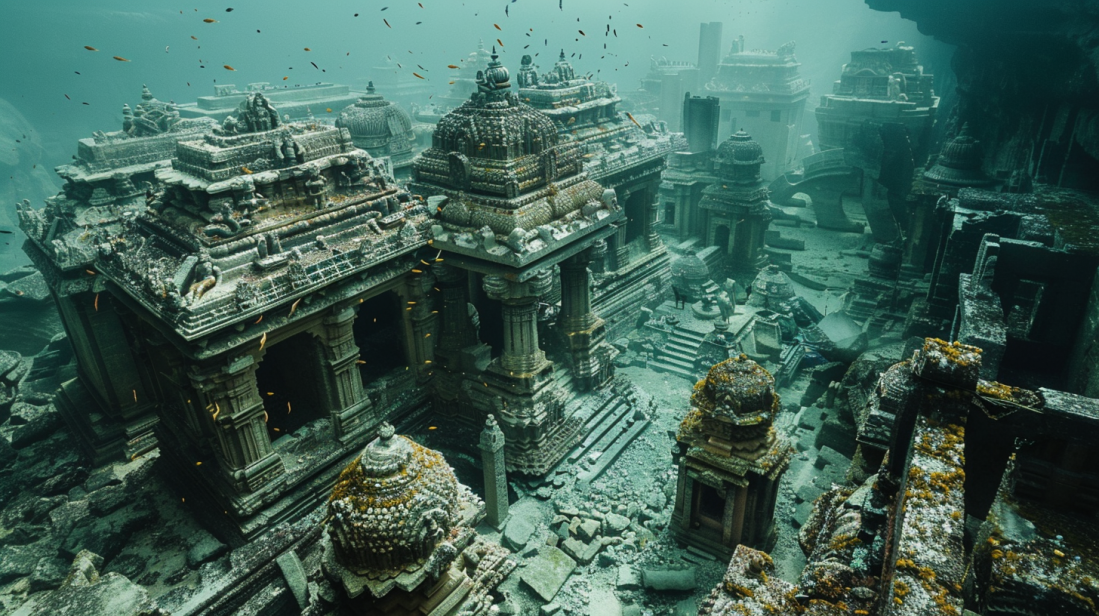Introduction
The ancient city of Dwarka, reputedly the legendary kingdom of Lord Krishna, has long captivated historians and archaeologists. Mentioned extensively in Hindu scriptures, Dwarka is described as a magnificent city that met a watery end, submerged under the sea thousands of years ago. Recent underwater explorations in the Gulf of Khambhat have uncovered ancient ruins, sparking renewed interest and debate about the historicity of this mythic city.
The Legendary City of Dwarka
According to Hindu mythology, Dwarka was a splendid city established by Lord Krishna. The city is depicted as a hub of prosperity and culture, adorned with grand palaces, lush gardens, and bustling markets. The Mahabharata and the Bhagavata Purana describe Dwarka’s eventual submergence, a poignant conclusion to its storied existence.
Historical References and Literary Sources
Dwarka’s legend is rooted in ancient texts. The Mahabharata, one of the major Sanskrit epics of ancient India, and the Bhagavata Purana, a revered scripture, provide detailed accounts of Dwarka’s glory and its eventual submergence. These texts have guided both the spiritual and academic quest to locate the sunken city.
Geographical Theories and Hypotheses
Numerous theories have been proposed about the precise location of ancient Dwarka. The most compelling evidence points to the Gulf of Khambhat, where marine archaeological explorations have identified promising sites. Geographical studies align with descriptions from ancient texts, reinforcing the hypothesis of Dwarka’s historical existence in this region.
Underwater Archaeological Discoveries
Recent underwater explorations in the Gulf of Khambhat have yielded remarkable findings. Divers and researchers have discovered remnants of structures, stone anchors, and pottery shards, all indicative of an ancient urban settlement. These discoveries have ignited debates among historians about their possible connection to the legendary Dwarka.
Significant Finds and Their Implications
The artifacts uncovered from the depths include well-defined structures, such as walls, steps, and pillars. Stone anchors and pottery shards suggest a maritime culture with advanced seafaring capabilities. These findings imply a sophisticated urban settlement, potentially corroborating the historical accounts of Dwarka.
Technological Advances in Marine Archaeology
Advancements in marine archaeology have played a crucial role in uncovering Dwarka’s secrets. Techniques such as sonar mapping, sub-bottom profiling, and underwater robotics have enabled researchers to explore and document submerged structures with unprecedented precision.
Dating the Artifacts and Structures
The dating of artifacts and structures is critical in validating Dwarka’s historicity. Radiocarbon dating and thermoluminescence testing of the discovered items suggest an age range that aligns with the timeline of Dwarka’s submergence as described in ancient texts. These scientific methods provide a temporal framework that supports the hypothesis of a sunken ancient city.
Cultural and Societal Insights
The artifacts and structures offer insights into the cultural and societal aspects of ancient Dwarka. The layout of the ruins suggests a well-planned urban settlement with advanced architectural and engineering knowledge. These findings reflect a highly organized society with a rich cultural heritage.
Religious and Mythological Significance
For many, Dwarka is not just an archaeological site but a place of immense religious and mythological significance. The connection to Lord Krishna imbues the city with spiritual importance, making the search for Dwarka a quest that transcends academic inquiry, touching the hearts of millions of devotees.
Challenges in Underwater Archaeology
Exploring submerged sites presents numerous challenges, including strong underwater currents, low visibility, and the degradation of organic materials. These factors complicate excavation efforts and necessitate the use of specialized equipment and techniques.
Interpreting the Findings
Interpreting the underwater findings requires a multidisciplinary approach, combining archaeology, geology, oceanography, and ancient literature. This holistic method ensures that the conclusions drawn are robust and scientifically sound, providing a clearer picture of Dwarka’s past.
Debates and Controversies
The discoveries have reignited debates about the historicity of Dwarka. Some scholars argue that the findings conclusively support the existence of the legendary city, while others call for more evidence. The discussion reflects the dynamic nature of archaeological research, where new findings constantly reshape our understanding.
Future Directions for Research
Future research aims to continue the exploration of the Gulf of Khambhat, employing advanced technologies to uncover more artifacts and structures. Further studies will focus on detailed mapping, excavation, and analysis to build a comprehensive understanding of Dwarka’s history and significance.
Conclusion
The search for the sunken kingdom of Dwarka remains one of the most captivating quests in archaeology. Recent underwater discoveries have provided tantalizing clues, suggesting a sophisticated urban settlement that aligns with ancient descriptions of Dwarka. As research progresses, the mysteries of this legendary city continue to unfold, offering profound insights into India’s ancient maritime heritage.
FAQs
What is the significance of Dwarka in Hindu mythology?
Dwarka is believed to be the legendary kingdom of Lord Krishna, described as a magnificent city that was eventually submerged under the sea.
Where is the proposed location of ancient Dwarka?
The most compelling evidence points to the Gulf of Khambhat in modern-day Gujarat, India.
What have recent underwater explorations uncovered?
Recent explorations have discovered remnants of structures, stone anchors, and pottery shards, indicating an ancient urban settlement.
How are the artifacts dated?
Artifacts are dated using radiocarbon dating and thermoluminescence testing, which suggest an age that aligns with the timeline of Dwarka’s submergence described in ancient texts.
Why is Dwarka’s discovery important?
Discovering Dwarka provides insights into ancient maritime trade, urban planning, and cultural heritage, and it holds significant religious and mythological importance.
What challenges do researchers face in underwater archaeology?
Challenges include strong underwater currents, low visibility, and the degradation of organic materials, which complicate excavation efforts and require specialized equipment.

